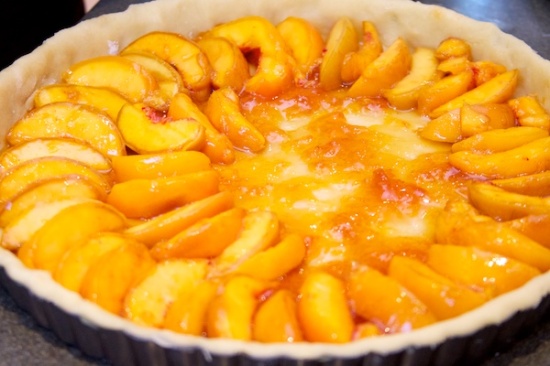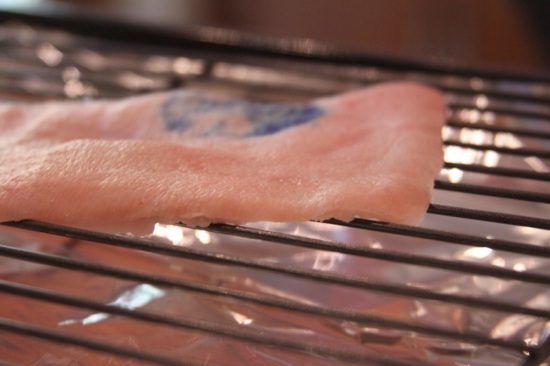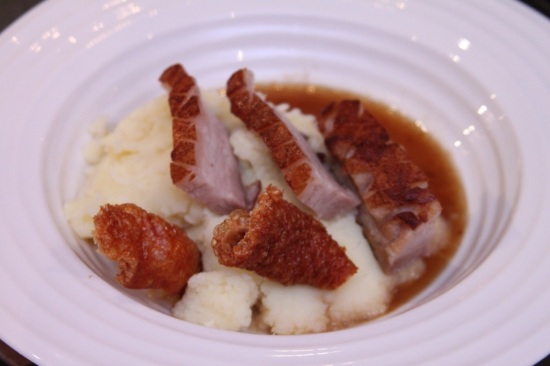In an ideal world, we’d have time to blog in detail about all our adventures in cooking. In reality, we cook, photograph and eat a lot more than we have time to write about. Here are a few recent dishes and some quick notes on sources, methods, and our impressions of the end product.
Insalata Caprese
Simple perfection: a variety of tomatoes from the back yard, fresh basil, olive oil, salt, pepper, and mozzarella di bufala. Sometimes, we add a drizzle of good balsamic vinegar to amp up the sweet and sour quotient.

Oops – here’s one with the mozzarella:

Celeriac Remoulade and Sous Vide Cod Fillet
We’ve been tearing through the excellent Heston Blumenthal at Home , a book that adds some modernist techniques and refinements to home cooking in a way that yields big return for little effort. Celeriac remoulade is finely shredded celery root in a sauce of homemade mayonnaise, studded with capers, pickles, lemon, tarragon and parsley. It acts as a sort of high-end tartar sauce/salad when served alongside unadorned white fish.
, a book that adds some modernist techniques and refinements to home cooking in a way that yields big return for little effort. Celeriac remoulade is finely shredded celery root in a sauce of homemade mayonnaise, studded with capers, pickles, lemon, tarragon and parsley. It acts as a sort of high-end tartar sauce/salad when served alongside unadorned white fish.
In this case, we used some sparklingly fresh cod, brined for 10 minutes in a 3% salt solution (30 grams of salt to 1 liter of water), cooked sous vide for 15 minutes at 60’C, and pan-seared on one side to give it crunch and colour. The brining and sous vide cooking gave the fish a supple, moist but not mushy texture that’s almost impossible to produce any other way. The homemade mayo was an ordeal (I tried using the Vitamix, but it still split, and the two of us resorted to the old-fashioned “whisk and elbow grease” method.) But it was so, so good.

Chamomile Panna Cotta
Another hit from the Heston Blumenthal book. Milk, infused with chamomile flowers, gently warmed with whipping cream, sugar and sheet gelatin.

A dusting of fructose (fine crystals of fruit sugar) and powdered chamomile emphasized the flavours of the panna cotta, and fresh peaches provided a fresh, zingy note. Unbelievably silky and quietly, soothingly delicious.

Peach Tart
This one’s from the excellent Salt to Taste: The Key to Confident, Delicious Cooking by Marco Canora.
by Marco Canora.

It’s a really simple tart composed of pastry, a layer of apricot preserves, and sliced peaches. The crust recipe is interesting: it’s vanilla-scented, and has a slightly cake-y texture owing to the presence of baking powder. We liked it a lot, but agreed that Thomas Keller’s pine nut crust would’ve been even better.

A sprinkling of icing sugar atop the hot peaches created a tasty glaze. Mmm. And didn’t MC Warmspice do a nice job of arranging the peach slices?
Spinach Crepes with Sauce Mornay
This was a totally fun weekend-evening activity/meal. We used Julia Child’s crepe batter recipe from Mastering the Art of French Cooking, and filled the crepes with super-fresh local spinach, blanched, drained and sauteed in butter with a little onion and a splash of vermouth.

These went into a 350’F oven, nestled in a buttered baking dish and napped with a white sauce enriched with nutmeg, grated Jarlsberg cheese, and a sprinkling of parmesan. A quick trip under the broiler (and the blowtorch to brown the gaps the broiler left behind, lol) and we had a lovely meal.

Seafood Tower
I’ve sort of been fantasizing about making my own seafood tower since I saw a picture of one in Au Pied de Cochon: The Album – from the temple of foie gras and pork fat in Montreal. (Unfortunately, when we visited, it was in the depth of winter.) Well, lobster is cheap this summer, so an indulgence like this doesn’t produce quite the same fiscal hangover that it otherwise might.
– from the temple of foie gras and pork fat in Montreal. (Unfortunately, when we visited, it was in the depth of winter.) Well, lobster is cheap this summer, so an indulgence like this doesn’t produce quite the same fiscal hangover that it otherwise might.
The thing about lobster is: it’s usually badly prepared. The shock of boiling water, a blazing grill, or superheated steam almost always make it tough and stringy. And too often, it’s boiled in water that’s sorely lacking in seasoning. That leaches flavour out of the lobster (basically making a wan lobster stock) rather than maintaining and enhancing its flavour. So, as usual (do I sound like a broken record? don’t answer that) we turn to Thomas Keller.

Start by making a court bouillon: a quick stock full of onions, leeks, carrots, fennel stalks, lemons, garlic, thyme, bay leaves, and peppercorns. Add water, white wine, and white wine vinegar. Bring that to a boil, and simmer it for 10 minutes. Bring it back to a boil. Now you’re ready for the lobster. Take your 1.5 to 2lb lobster, plunge him or her head-first into the boiling broth, and quickly put the lid on the stockpot. When the pot returns to the boil, uncover it, boil for 1 minute, then remove it from the heat, put the lid back on, and wait for 12 minutes. Carefully remove the lobster from the bouillon and let it cool down for 15 minutes before proceeding.

That will give you tender, flavourful, just barely cooked lobster meat, which you can then shell and chill (or, as Keller does at the French Laundry, warm up in a decadent butter emulsion).
Our seafood tower also featured mussels and B.C. spot prawns. For the prawns: bring the court bouillon back to the boil, dump the wriggling creatures into the broth, replace the lid, and as soon as the liquid returns to a simmer, remove it from the heat and let it sit, covered, for 5 minutes. Then remove the prawns and chill them.

For the mussels: Ladle an inch of the court bouillon into the bottom of a pot. Place the mussels on top of a steamer or rack. Steam them just until they open. When they’re cool enough to handle, remove half of each shell, free the mussel, remove its beard if present, and put the moules on the half-shell on a tray to chill. Cover it with plastic wrap to prevent the flesh from drying out.
From there, it’s easy: some quartered lemons, cocktail sauce, and a mignonette sauce of finely chopped shallots and black pepper with equal parts white wine vinegar and white wine.



















